Isolation. Later, general, fever, TB.
The Sisters Hospital for Infectious Diseases opened on 20th July 1893 to the west of the Folly Mead Estate, adjacent to the southern aspect of the St Albans workhouse. It had been financed by Sir John Blundell Maple (1845-1903) at a cost of £5,000. His two daughters, Winifred and Dorothy, had died of scarlet fever in successive years and the Hospital was named after them.
Sir John and his wife presented the fully equipped and furnished hospital to the City of St Albans. The City Council provided the administration and all patients received free treatment.
The Hospital consisted of an administration block, a ward block with 14 beds and an outbuilding block. All were connected together by covered walkways. There was also a self-contained caretaker's house. In one corner of the site was a raised platform, intended to be used for a tent hospital, should the need arise.
The administration block contained a consulting room and a drug room, the kitchen and its storerooms, a Nurses' Sitting Room and bedrooms for the nursing and domestic staff.
On the ground floor of the ward block were four wards - two with 3 beds each and two with 2 beds each - and three nurses' rooms. These were all approached from one corridor, which had windows that could be opened in the summer. On the upper floor over the central portion of the block were two further wards and a nurses' room. The layout of the block precluded the treatment of more than one infectious disease at a time.
In the outbuildings block were an ambulance shed, a disinfection house, a wash-house and laundry, a coalhouse and a mortuary.
However, the Hospital lacked a moveable bath and a steam disinfector, making use only of a hot air chamber for disinfecting patients' clothes.
The site also had no proper drainage system. The closets were all on the dry earth system and liquid slops were carried to a cesspool, whence they soaked into the ground - an unfortunate arrangement for any hospital, let alone one for infectious diseases.
By the end of its opening some 69 cases of scarlet fever had been treated at the Hospital, of which only one died. A permanent Matron was appointed in December 1893.
In April 1896 two partitions with doors were erected within the corridor in order to divide the ward block into three separate parts, so that other infectious disease patients could be admitted, if necessary. During that year, some 146 patients (mostly children) were treated for scarlet fever.
In 1900 the Hospital dealt with 20 cases of scarlet fever and 2 of diphtheria. In 1901 84 patients with scarlet fever were treated.
In 1903 the Hospital was enlarged, with the erection of a proper discharge room and the addition of two bathrooms for the patients. Heating was installed in the corridor.
In 1904 an adjacent piece of land on the Folly Mead Estate was purchased with a view to future expansion. The Medical Officer of Health had long urged for the building of a Diphtheria Block and an Enteric Fever Block.
In 1909 the Hospital Committee submitted plans for the much-needed Diphtheria Block. As the Hospital could only admit scarlet fever cases, other arrangements had to be made for the isolation of patients with diphtheria. In 1909 two houses in Harpenden had to be rented as a temporary measure for that purpose.
However, it was not until January 1911 that a tender of £1,749 for the erection of the Block was accepted. Work began and was completed the same year.
By 1913 the Hospital had acquired a Thresh Steam Disinfector, in which infected bedding, clothes and other articles collected from patients' homes could be disinfected. The patients' premises were also fumigated and washed down with soap and water.
By 1920 the Hospital had again been extended. The Scarlet Fever Block had 30 beds. It also contained two wards of 3 beds each for cerebrospinal fever (meningitis) cases. The Diphtheria Block had 12 beds.
In 1921 102 cases of scarlet fever were treated, and 84 of diphtheria.
By 1924 a new entrance had been made to the Hospital from Folly Avenue, although the previous track off Union Lane along the east side of the workhouse still remained.
In 1925 the Scarlet Fever Block contained 24 beds for scarlet fever patients and two wards of 4 beds each for those with cerebrospinal fever.
During the 1930s a Washington Lyon Steam Disinfector was purchased. More land was acquired and work began to enlarge the Hospital. A new entrance was made and, by 1938, when it changed its mailing address from Union Lane to Folly Avenue, it had 45 beds.
More ward blocks were added to the site, after which the bed capacity had doubled in size by the time of the outbreak of WW2 in 1939.
On joining the NHS in 1948 the Hospital was absorbed by the adjacent St Albans City Hospital, coming under the control of the Mid-Herts Group Hospital Management Committee. It was then renamed the St Albans City Hospital (Sisters Unit).In 1949, during a large nationwide outbreak of poliomyelitis, 17 suspected cases of the disease were reported in the St Albans area. Three patients died, but the others made good recoveries following treatment at the Hospital.
In 1951 the Hospital had 94 beds - 31 for general cases, 32 for fever and 31 for tuberculosis.
Like many other infectious disease hospitals, with the advance of antibiotics, it became superfluous. It closed in 1953.
Present status (September 2008)
The Hospital buildings are now Harriet Heights and The Sisters Lodge in Goldsmith Way, a new road.

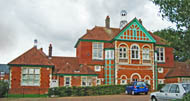
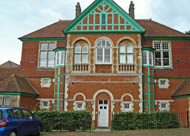
The former Hospital building is now Harriet Heights.
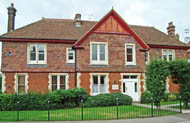

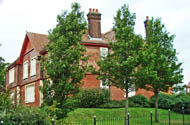
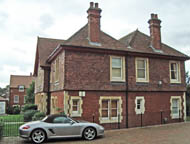

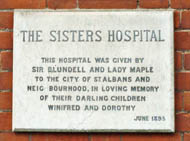
The front elevation of The Sisters Lodge bears the original foundation stone of the Hospital built by the Folly Mead Estate.
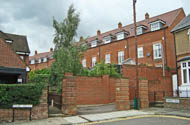
Perhaps some gate posts of the entrance to the Hospital by the footpath at the end of Folly Avenue.
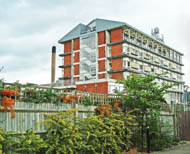
The St Albans City Hospital looms over the former Sisters Hospital buildings.
He became the Conservative MP for Dulwich in 1887 and was knighted in 1892, and made a baronet in 1897. He was a generous public benefactor. As well as the Sisters Hospital in St Albans, he also donated the land for a public park and sports ground close to his home, Childwickbury, to the north of St Albans (more recently the home of Stanley Kubrick). He also paid for the rebuilding of University College Hospital in Gower Street, adjacent to his furniture store, Maples.
A keen race-goer, he owned a large stud of racehorses which from 1885 won many important races (racing at first under the ownership of 'Mr Childwick'). He died in 1903 at the age of 58 from Bright's disease (nephritis), two months after he was admitted to the Jockey Club.
His only surviving daughter married Baron Hermann von Eckardstein, first secretary of the German Embassy, in 1896. In 1907 she brought an action for separation on the grounds of cruelty, mainly for making her pay his gambling debts, which amounted to $2m.
(Author unstated) 1893 Hospital construction. The Sisters Hospital, St Albans, Herts. The Hospital, 2nd September, 365-366.
Fremantle FE 1909 Twelfth Annual Report on the Public Health of Hertfordshire. Hertfordshire County Council, 53.
Fremantle FE 1910 Thirteenth Annual Report on the Public Health of Hertfordshire. Hertfordshire County Council, 65.
May HE 1913 Annual Report of the Medical Officer of Health. St Albans, 26.
May HE 1920 Annual Report of the Medical Officer of Health. St Albans, 13-15.
Mein J, Wares A, Mann S (eds) 2016 St Albans: Life on the Home Front, 1914-1918. Hatfield, Hertfordshire Publications.
Morison J 1893 Annual Report of the Medical Officer of Health. St Albans, 10.
Morison J 1896 Annual Report of the Medical Officer of Health. St Albans, 23-24.
Morison J 1902 Annual Report of the Medical Officer of Health. St Albans, 6-7.
Morison J 1904 Annual Report of the Medical Officer of Health. St Albans, 9-10.
Morison J 1909 Annual Report of the Medical Officer of Health. St Albans, 9.
Paton RRK 1925 Annual Report of the Medical Officer of Health. St Albans, 13.
Paton RRK 1937 Annual Report of the Medical Officer of Health. St Albans, 8, 10.
Sleigh JC 1948 Annual Report of the Medical Officer of Health. Harpenden Urban District Council, 16.
Sleigh JC 1948 Annual Report of the Medical Officer of Health. St Albans Rural District Council, 18-19.
Sleigh JC 1949 Annual Report of the Medical Officer of Health. St Albans City and St Albans Rural District Council, 27-28.
Sleigh JC 1951 Annual Report of the Medical Officer of Health. St Albans City and St Albans Rural District Council, 14.
http://hertfordshire-genealogy.blogspot.com
www.bbc.co.uk
www.british-history.ac.uk
www.flickr.com
www.harpenden-history.org.uk
www.lookandlearn.com
www.nationalarchives.gov.uk
www.stalbans.gov.uk
www.stalbanshistory.org
www.walk-talk.co.uk
Return to home page